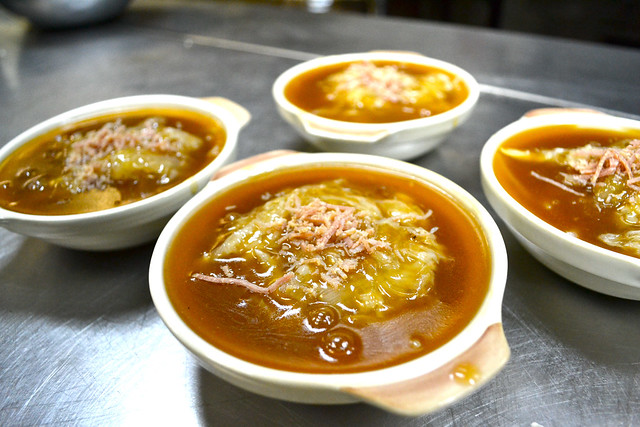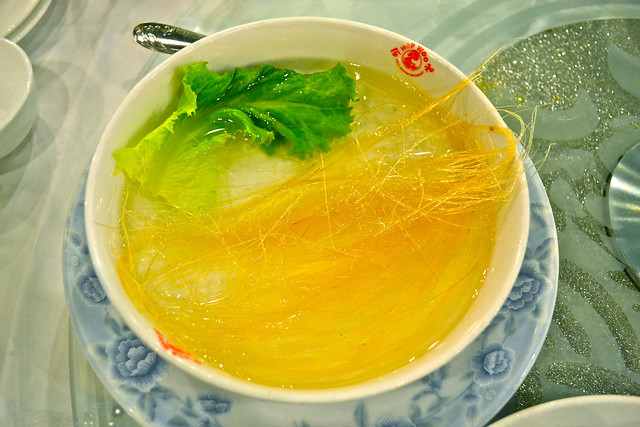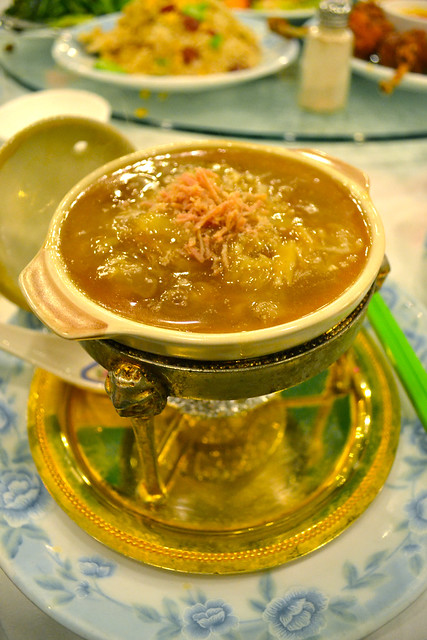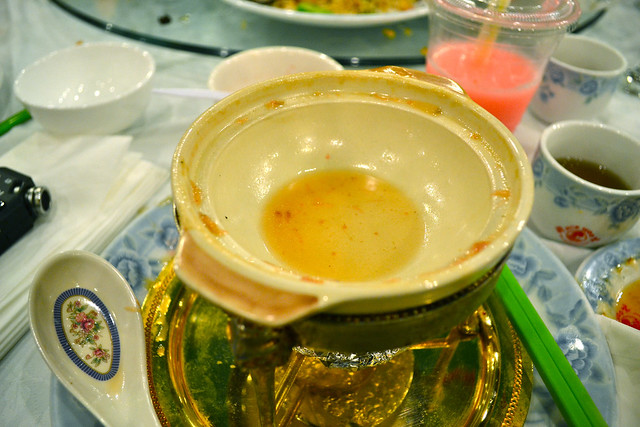Shark Fin Soup Jumps the Shark. 2012, the Outlawing of Shark Fin & How to Cook it. Hop Woo BBQ. Chinatown, CA.

About to jump 4 bowls of shark fin soup on water skis & in cut off shorts.
California Bill AB 376, the proposed law making it unlawful for any person to possess, sell, offer for sale, trade, or distribute a shark fin, as defined, was signed into law by Governor Jerry Brown back in October 2011. It's now 2012 and the law is in effect, however, the current supply of shark fins in the state can be sold until July of 2013.
Basically, shark fin has jumped the shark.
2012 (at least in California) appears to be the year of the food ban with foie gras also looking at full outlaw status but on July 2012.
Although my lips haven't touched shark fin since the last Chinese wedding banquet I attended almost a decade ago, I decided to revisit the controversial yet culturally significant delicacy and have one last taste before it's banned for good or only available along side meth labs in sketchy neighborhoods of Fontana.
But before I get to the tasting, you should know a little about why Shark Fin Soup is culturally significant to Chinese cuisine. It began many hundreds of years ago during the Ming Dynasty (1368–1644) or perhaps as early as the Sung Dynasty (960–1279). It was always seen as a luxury dish due to its difficulty in harvesting and time-consuming, elaborate preparation process.
Shark fin can be served intact as a whole fin, but typically it is presented in a fibrous, almost noodle like fashion. Often the ingredient is used in a soup or stew. Shark fin represents wealth and prestige and serving it to guests bestows upon them honor, respect or "face".

Dried strands of shark fin fibers.
Purchasing a dried shark fin off the legitimate market will set you back about $2000 to $3000 for the large dorsal fin.
The process for making shark fin soup begins with the reconstituting of the dried fin which takes about 3 days of overnight boiled water baths. Cleaning and skinning of the fin is also involved.
On day 3, the fibrous strands of the fin began to separate from the cartilage. These strands are removed completely and pulled into individual fibers. The cartilage is used for the soup's stock.

Final stage of shark fin reconstitution.
The shark fin fibers feel a lot like nylon thread and are soaked for another night to complete the reconstituting process.

The fancy shark fin soup presentation at Hop Woo.
Shark fin is not where the soup's flavor resides. At Hop Woo in Los Angeles' Chinatown, chicken, beef and Chinese ham along with onion, ginger and other seasonings are placed together in the shark fin cartilage stock for 4 hours. Finally after over 4 days of prep time, it's ready to serve.

The rich man's soup.
The soup itself is a bounty of flavor none of which is shark. The shark fin is almost void of taste. It's the slippery, crunchy, dense, glass noodle-like texture that is the appeal.
With a slight sting of guilt, I slurped up this very savory, robust, thick soup that had the viscosity of a sweet and sour soup. My teeth cleaved a cord of shark fin fiber causing them to snap and pop with an audible though subtle crunch.
Although the Chinese food culture in California has lost a luxurious delicacy that is designed to make the eater feel richer, hopefully with the shark fin ban our oceans will begin regaining its wealth in sharks once again.
The current inventory of shark fin is legal for purchase and sale through July 2013 when the total ban on shark fin takes effect.

So long shark fin.
Hop Woo BBQ
845 North Broadway
Los Angeles, CA 90012
213.617.3038
Comments